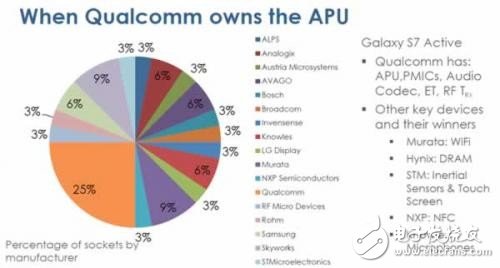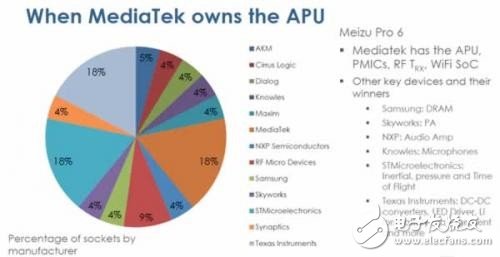In the field of mobile phone chips, our eyes are focused on large chips (application processors, APU or AP for short). Due to the increasingly fierce competition, there are still people who have quit, and now there are only a handful of application processor vendors. But now, the war has burned to chips outside the application processor.
After the merger of Chipworks, the research organization TechInsights has enhanced its analytical capabilities for semiconductors. At the Linley Group Mobile Conference held today, TechInsights throws a point that the application processor is the winner. Through a set of charts, TechInsights concludes that in a mobile phone, the application processor supplier is very likely to get This phone has 25% to 45% of all chip shares.
TechInsights dismantled a high-end model of the Samsung Galaxy S7. Since Samsung replaced PartalPlayer for Apple's iPod supply chip more than a decade ago, Samsung has adopted a bundled sales strategy to maximize its productivity in memory (DRAM) and flash memory. In the Galaxy S7, Samsung supplies more chips, such as fingerprint sensors, NFC chips, touch screen controllers, and even many power management and RF front-end chips.

Chip supplier status with Samsung processor phones
Qualcomm is also sparing no effort to promote its RF technology. Qualcomm has turned its attention to the millimeter-wave RF front-end field, and the prospects for millimeter-wave in 5G, automotive electronics and other applications are excellent. Compared with Samsung, when a mobile phone adopts Qualcomm application processor, the chip supplier is more dispersed, and other manufacturers have more opportunities. In the dismantled Samsung Galaxy S7 AcTIve, Qualcomm provides application processors, power management chips, audio chips and RF receiver chips.

Chip supplier status with Qualcomm processor phones
MediaTek's chips are cheaper, but the peripheral chips around the application processor are roughly the same as the two above. MediaTek's platform also requires chips such as DRAM, flash memory, MEMS sensors, RF amplifiers, and microphones. In the dismantled Meizu Pro 6, MediaTek provides application processors, power management, RF receiver chips and WiFi chips.

Chip supplier status using MediaTek processor phones
Although the above three case samples are too small, the conclusions are for reference only, but the above cases do show a possibility that the chip suppliers of low-end and mid-range mobile phones are more dispersed and more competitive. In order to enter the Apple supply chain, the suppliers have self-restricted and did not adopt the bundled sales plan. As more and more high-end mobile phones are used by low-end mobile phones, the suppliers will enter the Chinese mobile phone manufacturers in the next few years. Killed.
This indicates that in the near future, there will be more semiconductor mergers and acquisitions, just like ADI's acquisition of Linear Technology. Fields such as RF, MEMS and touch screen interfaces are possible.
High Voltage Module,High Voltage Power Module,High Voltage Booster Module,High Voltage Power Supply Module
Yangzhou IdealTek Electronics Co., Ltd. , https://www.idealtekpower.com
